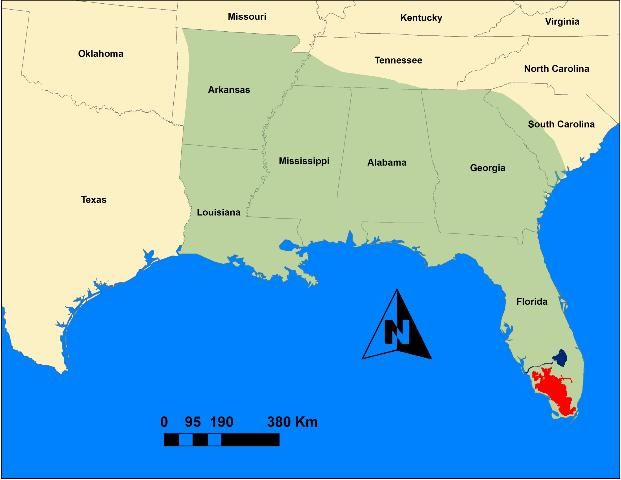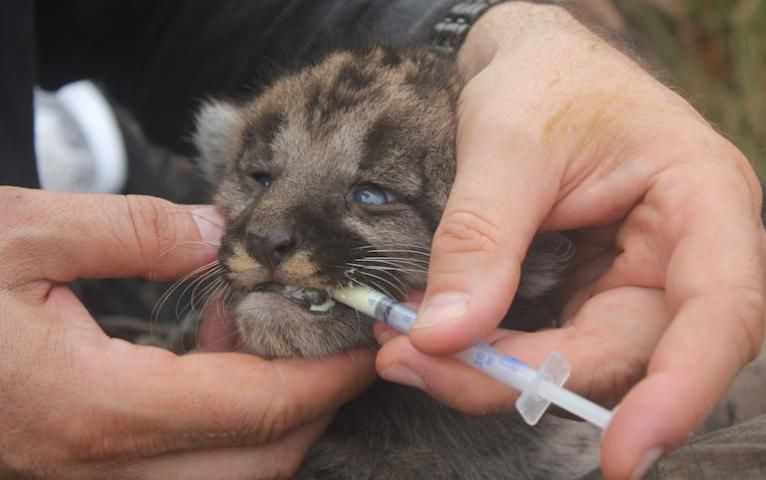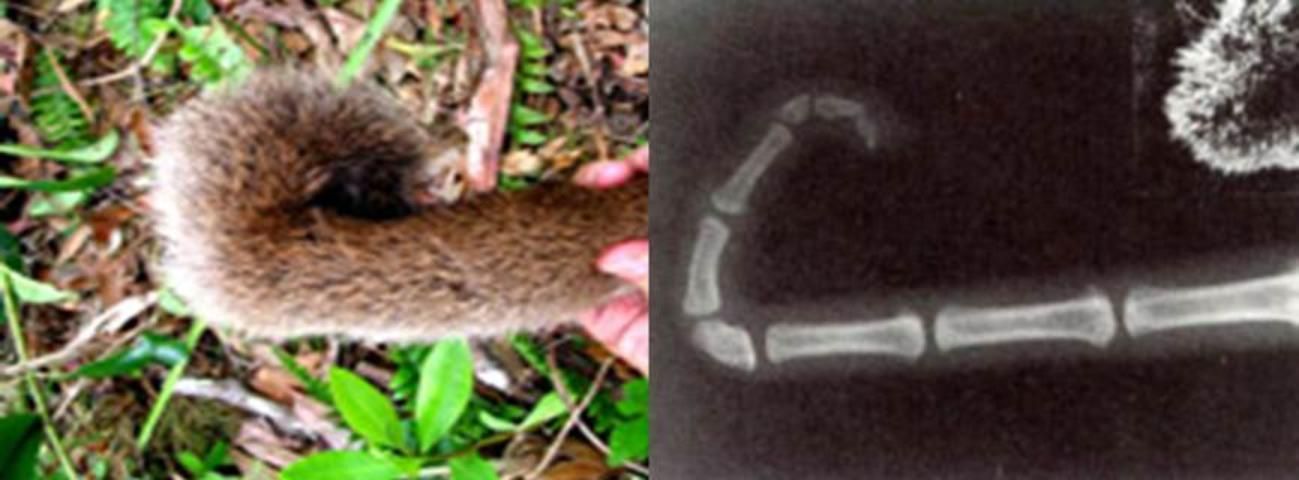The Florida panther (Puma concolor coryi) is a subspecies of North American puma that once roamed throughout Florida and much of the southeastern United States. However, the only existing breeding population currently occurs south of the Caloosahatchee River in south Florida (Figure 1), which represents about 5% of its original range. Early European settlers in the region viewed Florida panthers as a threat to livestock and as competitors for game. At one point in time, the state of Florida even had a bounty on panther scalps. Habitat loss and persecution by humans brought the Florida panther to presumed extinction by the early 1950s, but they were rediscovered in 1973 by a survey team organized by the National Geographic Society (Johnson et al. 2010). They were one of the first species to be added to the US endangered species list and are now the only population of North American puma that occurs east of Mississippi River.

A panther research program was initiated by state and federal wildlife agencies in 1981. Since then, biologists have tracked Florida panthers using very high frequency (VHF) and geographic positioning system (GPS) radio collars. Since 1995, researchers have used radio-tracking data to determine if radio-collared females are denning and to pinpoint den locations so kittens could be medically examined and tagged. These den visits have been greatly facilitated by the development of a device called a "biologist in a box" (Figure 2) (Land, Garmand, and Holt 1998). This device consists of a telemetry receiver with antenna and a cell phone with antenna, all powered by a car battery. Researchers place the box near a den so that they can call the cell phone to find out whether the female is at the den or away from the den, and determine when it is safe to approach the den and handle the kittens. The kittens are counted, sexed, dewormed (Figure 3), and permanently marked with subcutaneous Passive Integrated Transponder (PIT)-tags. Stool and tissue samples are also collected for analyses. Thanks to the PIT-tags (which are the same as those commonly used for pets), the kittens can be identified if they are recaptured later in life or recovered after death.

Credit: FWC
Early research revealed that the Florida panther population was in trouble. The population was estimated to consist of only about 20 to 30 sub-adults and adults during the early 1990s (McBride, McBride, and McBride 2008), and many of the panthers suffered from biomedical and morphological abnormalities that are rare in healthy populations of North American pumas. These abnormalities included atrial septal defect (a heart defect allowing blood flow between the two chambers of the heart), and cryptorchidism (undescended testicles in males). Cryptorchidism can occur on one side (unilateral) or on both sides (bilateral), and males that are bilaterally cryptorchid are incapable of reproducing. Many panthers had kinked tails for the last five vertebrae (Figure 4), cowlicks of fur on their dorsal side, heavy parasite loads, and a reduced immune response. Males also had low sperm counts and poor sperm quality (Roelke, Martenson, and O'Brien 1993; Culver et al. 2000). All these traits were likely the result of inbreeding. Inbreeding is the production of offspring from mating among close relatives. Inbreeding usually occurs in small, isolated populations such as the Florida panther population. It generally results in increased birth defects, lower genetic variation, and reduced fitness, which were also observed in Florida panthers.
To improve the chances for the Florida panther population to persist, almost 300,000 acres of panther habitat became protected, prey management was improved, and highway underpasses were created. These conservation measures, although important, could not directly help to restore the genetic health of the population, and the population therefore still faced a substantial risk of extinction. Because of frequent inbreeding and low numbers of viable offspring, conservation biologists recommended genetic restoration as a management tool to improve the genetic health of the panther population. Genetic restoration (also called genetic rescue or genetic introgression) is defined as an improvement in fitness of inbred populations through low-level immigration of genetically divergent individuals.

Credit: Madelon van de Kerk, UF/IFAS
Genetic restoration was a controversial management action and created a lot of discussion about its potential benefits as well as risks (Creel 2006; Maehr et al. 2006; Mills 2006; Pimm, Bass, and Dollar 2006a; Pimm, Dolalr, and Bass 2006b). Eventually, genetic restoration was implemented in 1995 by releasing eight female Texas pumas (Puma concolor stanleyana) in Florida panther habitat in south Florida. Texas pumas were chosen as donors because historic gene flow between the Florida and Texas subspecies occurred before the isolation of the Florida panther population in south Florida. Females are generally preferred for genetic restoration attempts because biologists can more effectively monitor their reproductive success than that of males. Five out of eight Texas females reproduced, resulting in 12 litters and at least 20 kittens. Five Texas females died in the wild from natural causes, and three were removed by managers to prevent the possibility of excessive levels of Texas puma genes in the Florida panther population. By 2003, no Texas pumas remained in the wild in south Florida.
Benefits of the genetic restoration include an increase in panther numbers from between 20 and 30 individuals to about 120 (McBride et al. 2008) and a younger, healthier population. The average age of panthers dropped during the first approximately 10 years after genetic restoration and started to increase again in 2004, indicating a growing and then stabilizing population. The average heterozygosity (a measure of genetic diversity) increased from 16% to 24%. The frequencies of atrial septal defects, cryptorchidism, kinked tails, and cowlicks decreased substantially (Johnson et al. 2010). Survival of admixed panthers (panthers with Texas genes) was better than that of non-introgressed panthers (panthers without Texas genes). In particular, admixed kittens survived better than non-introgressed kittens (Hostetler et al. 2010). A recent study showed that the panther population experienced an average long-term growth rate of 4 to 5% per year after the genetic restoration and currently faces low probability of extinction. Furthermore, this study revealed that without genetic restoration, the population would have continued to decline and that it would have faced substantial risk of extinction (Hostetler et al. 2013).

Credit: FWC
Given the increase in genetic diversity and panther population size and the corresponding decrease in the frequency of inbreeding traits, genetic restoration has been considered a success. However, Florida panthers continue to face many challenges. Florida panther habitat continues to shrink due to ongoing land development and habitat fragmentation. The lack of sufficient space for an expanding panther population may help explain the increasing incidence of panthers killed in fights with other panthers. Vehicle collisions are another important source of panther mortality, and these have increased drastically over the past few decades, despite the construction of highway underpasses. Other potential threats to Florida panthers include climate change, disease, and the potential for persistent genetic problems. Because the population is still relatively small and isolated, there is a high probability that the frequency of inbreeding related traits will increase again at some point in the future and genetic restoration may have to be repeated. Therefore, current research focuses, in part, on planning for prospective genetic restoration so that inbreeding depression will not threaten the population with extinction again.
References and Further Reading
Creel, S. 2006. "Recovery of the Florida panther--genetic rescue, demographic rescue, or both?" Response to Pimm et al. (2006). Animal Conservation 9:125–126.
Culver, M., W. E. Johnson, J. Pecon-Slattery, and S. J. O'Brien. 2000. "Genomic ancestry of the American puma (Puma concolor)." Journal of Heredity 91:186–197.
Hostetler, J. A., D. P. Onorato, D. Jansen, and M. K. Oli. 2013. "A cat's tale: the impact of genetic restoration on Florida panther population dynamics and persistence." The Journal of Animal Ecology 82:608–20.
Hostetler, J. A., D. P. Onorato, J. D. Nichols, W. E. Johnson, M. E. Roelke, S. J. O'Brien, D. Jansen, and M. K. Oli. 2010. "Genetic introgression and the survival of Florida panther kittens." Biological Conservation 143:2789–2796.
Johnson, W. E. et al. 2010. "Genetic Restoration of the Florida Panther." Science 329:1641–1645.
Land, E. D., D. R. Garman, and G. A. Holt. 1998. "Monitoring female Florida panthers via cellular telephone." Wildlife Society Bulletin 26:29–31.
Maehr, D. S., P. Crowley, J. J. Cox, M. J. Lacki, J. L. Larkin, T. S. Hoctor, L. D. Harris, and P. M. Hall. 2006. "Of cats and Haruspices*: genetic intervention in the Florida panther." Response to Pimm et al. (2006). Animal Conservation 9:127–132.
McBride, R. T., R. M. McBride, and C. E. McBride. 2008. "Counting pumas by categorizing physical evidence." Southeastern Naturalist 7:381–400.
Mills, M. G. L. 2006. Response to article: "The genetic rescue of the Florida panther" by Pimm et al. (2006). Animal Conservation 9:123–124.
Pimm, S. L., O. L. Bass, and L. Dollar. 2006a. "Ockham and Garp." Reply to Maehr et al.'s (2006) response to Pimm et al. (2006). Animal Conservation 9:133–134.
Pimm, S. L., L. Dollar, and O. L. Bass. 2006b. "The genetic rescue of the Florida panther." Animal Conservation 9:115–122.
Roelke, M. E., J. S. Martenson, and S. J. O'Brien. 1993. "The consequences of demographic reduction and genetic depletion in the endangered Florida panther." Current Biology 3:340–350.